1950: From a purely financial perspective, this was not a good year. Television had cut movie attendance by half. The days of selling a film based on the strength of a ‘star’ were over. Top grossing films included Samson and Delilah, The Third Man, King Solomon’s Mines, The Asphalt Jungle and All About Eve (which also took home the Best Picture Oscar of that year). Irving Berlin’s Annie Get Your Gun had a change of cast after Judy Garland was fired and replaced by Betty Hutton. Reportedly, Berlin was not pleased with the final results of the film though it became a lucrative moneymaker for MGM. Judy Holliday stammered to Oscar victory as the year’s Best Actress, as dimwitted Billie Dawn in Born Yesterday. Sunset Boulevard. was also a hit. Billy Wilder’s scathing black comedy cast an appalling glare on the industry, so much that upon leaving the theater, MGM head, L.B. Mayer reported told Wilder – “You should be tarred and feathered and run out of Hollywood!”
Stanley Kramer produced two enduring classics; Cyrano de Bergerac and The Men – the latter transforming the career of relative newcomer Marlon Brando into box office gold. The foreign film market delivered Devil in the Flesh and, Kind Hearts and Coronets; the latter introduced North American audiences to Alec Guinness and Peter Sellers. Britain’s most popular star, Michael Wilding appeared to reasonably good effect in one of Alfred Hitchcock’s minor thrillers; Stage Fright. Elizabeth Taylor, who would eventually marry Wilding, took her first stab at marriage to hotel heir, Nicky Hilton on May 6, declaring “I just love everything about getting married.”
Two of Hollywood’s most gifted screenwriters – Dalton Trumbo and John Howard Lawson were imprisoned for their political beliefs following a lengthy trial by HUAC. The unofficial blacklist included such names as song and dance man Gene Kelly, comedian Danny Kaye, tough guy Humphrey Bogart and sultry Lauren Bacall. The artistic community was saddened by the deaths of Sid Grauman (of Grauman’s Chinese Theater fame), Rex Ingram, and character actors Emil Janning, Sara Allgood, Alan Hale and Walter Huston.
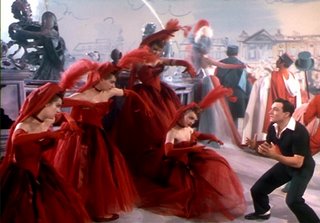
1951: The specter of television continued to cut deep into every studio’s bottom line. MGM was particularly hard hit perhaps because television’s almost daily diet of light comedy and musical variety shows attacked their two most lucrative genres (the romantic comedy and the musical). Dore Schary, who had been appointed as head of production by L.B. Mayer took over the studio after Mayer was fired by East Coast Metro boss, Nicholas Schenk.
Detective Story, The Great Caruso, Oliver Twist were critical and financial successes. Disney’s Alice in Wonderland was only modestly received – mostly by those who hadn’t read the Lewis Carroll novel. The Red Badge of Courage proved a controversial film that did little business at the box office. Two debuts: opera sensation Ezio Pinza (in a flop; Mr. Imperium) and Rock Hudson (drawing swoons from a growing number of female admirers who wanted to see more.) Oscars to An American in Paris (Best Picture), Vivien Leigh (Best Actress for A Streetcar Named Desire) and Humphrey Bogart (Best Actor; The African Queen). Death claimed Warner Baxter and Jack Holt. Robert Walker (the elegant psychopath in Hitchcock’s Strangers on a Train) died of an allergic reaction.
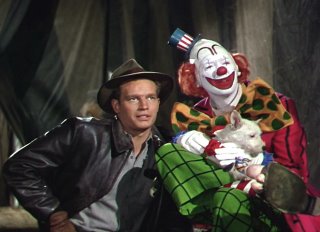
1952: Hollywood turned to epics and westerns (the only two genres guaranteed box office) for its bread and butter. High Noon, Ivanhoe, The Snows of Kilimanjaro, Viva Zapata! and The Quiet Man were all critical and financial successes. Remakes of The Prisoner of Zenda and The Merry Widow failed to eclipse the resilient charm of their originals. But Scaramouche (starring Stewart Granger) was a popular and lavish update. In an effort to cut costs, MGM began experimenting with a new single-negative film stock – Anscocolor. Soon Fox and DeLuxe, and, Eastman-Kodak began developing their own single strip film stocks. None of their early efforts, however, could rival the rich hues and saturation of the old Technicolor process.
One of the grandest disappointments of the year was RKO’s highly publicized Androcles and the Lion, based on George Bernard Shaw’s play. Limelight proved to be the last film Charlie Chaplin produced in America. Elizabeth Taylor racked up husband #2; Michael Wilding on Feb. 21. The entertainment industry said goodbye to legendary stage chanteuse, Gertrude Lawrence, director Jack Conway, and actresses Gladys George and Hattie McDaniel.
New stars on the horizon included bronzed Apollo of the surf board set - Tab Hunter and cool ice princess (soon to be genuine princess) Grace Kelly. Comedy teams were all the rage: Abbott & Costello, Bing Crosby and Bob Hope, and, Dean Martin and Jerry Lewis were untouchable. Mario Lanza drew in big crowds. Honors (and the Best Picture Oscar) went to Cecil B. DeMille’s The Greatest Show on Earth. But the biggest buzz in town was This Is Cinerama – the first widescreen movie photographed and exhibited employing a cumbersome three camera/projector set up. It opened on Sept. 30, 1952 and played for a record 122 weeks!
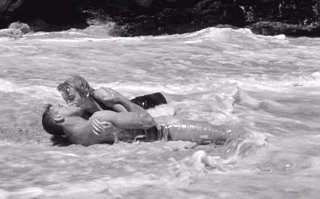
1953: Drive in theaters became all the rage. Cavernous movie palaces – those deified centers dedicated to the once promising arts - began to close. 3-D made a big – though short-lived splash – with Bwana Devil. Widescreen technologies became all the rage – except that no one could decide on a standardized format. Mike Todd introduced his answer to Cinerama; Todd A-O. Paramount created VistaVision high fidelity. 20th Century Fox inaugurated Cinemascope – by far the most enduring of the early ventures. Fox’s first two films in Cinemascope, The Robe (though turgid and dull in action) and How to Marry a Millionaire were nevertheless colossal hits.
Not everybody went widescreen and those that did not, compensated by producing some very intelligently crafted product: Shane, The Band Wagon, Julius Caesar, Moulin Rouge and From Here to Eternity which won the Best Picture Academy Award. Disney was zero for two with another adaptation of a beloved British novel – Peter Pan – technically stunning, yet somewhat failed in its ability to recapture the spark of Barrie’s original.
Marilyn Monroe – merely glimpsed in her previous efforts (The Asphalt Jungle, All About Eve and Clash By Night) scored big as the treacherous two-timer in Niagara. Stage diva, Ethel Merman made her splashy return to films in a faithful adaptation of Irving Berlin’s Call Me Madam. The world was introduced to Dutch born gamin, Audrey Hepburn in Roman Holiday. Doris Day sought to ditch her squeaky clean façade by playing the lead in Calamity Jane – though nothing could entirely erase the fact that Ms. Day was in fact a lady.
Two other debuts worth noting: demure Julie Harris in The Member of the Wedding, and, Anthony Perkins in The Actress. Death took veteran actors William Farnum, Nigel Bruce, Herman Mankiewicz, Lewis Stone, Roland Young and Herbert Ralinson.
1954: Judy Garland marked her comeback to films with A Star Is Born – an epically tragic and thrilling musical remake. The uniquely original Seven Brides for Seven Brothers rang cash registers across the country. Brigadoon – the film version of Lerner and Loewe’s Broadway smash that MGM had invested more money, time and effort in – was only a modest success. All three films were shot in Fox’s patented Cinemascope widescreen process. Paramount inaugurated VistaVision High Fidelity with their loose remake of Holiday Inn, re-titled White Christmas.
Hitchcock thrilled audiences with his voyeuristic suspense, Rear Window. Otto Preminger attempted an all black version of Bizet’s Carmen – starring Dorothy Dandridge. On a more serious note, MGM produced Bad Day At Black Rock – a story of bigotry and murder in an isolated town. The Caine Mutiny, Three Coins in the Fountain and The High and the Mighty were all box office powerhouses. When asked about his involvement in the latter, John Wayne replied, “I’m no actor. I just react to situations and what’s said to me.”
Athlete Bob Mathias starred in a highly successful film about his own life. It was a banner year for Marlon Brando who appeared in Desiree, The Wild One and On The Waterfront – winning Best Actor and the New York Film Critics Award for his performance in the latter. Grace Kelly won Best Actress for The Country Girl. Veteran talents, Lionel Barrymore, Eugene Palette and Sidney (the Fat Man) Greenstreet both died.

1955: The biggest story of the year did not happen on the screen but on a lonely road in Salinas where promising new talent James Dean met with an untimely death in an auto accident. Dean, appeared in only three films; East of Eden, Rebel Without A Cause and the as yet unfinished Giant (costarring Elizabeth Taylor and Rock Hudson). Twenty-five year old Robert Francis – another promising talent was killed in a plane crash. Hollywood’s list of dead celebrities also included Carmen Miranda, John Hodiak and Theda Bara.
There was good news too: John Wayne remained top man at the box office for the tenth consecutive year. Marilyn Monroe had her biggest hit to date with The Seven Year Itch – a feather weight comedy all about a married man’s infatuation with the girl living directly above him. Rock Hudson became every woman’s fantasy. Hitchcock delivered one of his most slick and stylish thrillers, To Catch a Thief.
Mike Todd christened Todd A-O with a roadshow engagement of Rodgers & Hammerstein’s Oklahoma! The film was also shot in Cinemascope to accommodate theaters not equipped for Todd’s widescreen process. Samuel Goldwyn produced a film version of the Broadway smash Guys and Dolls. His first choice for the lead, Sky Masterson was dancer, Gene Kelly. Instead he settled on Marlon Brando who gave the performance of his career. Burt Lancaster turned his attentions to producing along with partner Ben Hecht. Their film debut, the modestly budgeted B&W- Marty won Best Picture.
1956: “We’ve got to do something to get people away from TV.” – Karl Malden. Those sentiments were echoed in Hollywood’s mammoth output. Cecil B. DeMille suffered a heart attack while making his last film – The Ten Commandments – but proceeded onward till the end. Paramount made a valiant attempt at bringing Tolstoy’s War and Peace to the screen but it proved a disheartening and dull experience.
Hollywood continued to pillage Broadway for its own fodder: The King & I, Anastasia, Tea and Sympathy, Picnic, Bus Stop, The Rain Maker and Carousel were among the better offerings. Of the output specifically crafted for the movies; Vincente Minnelli’s Lust for Life was the most engrossing and a tour de force for Kirk Douglas. Paul Newman had his breakout performance as fisticuffs champion Rocky Graziano in Somebody Up There Likes Me. Twenty-six year old Robert Wagner became the latest heartthrob.
Remakes were all the rage – at least as far as studios were concerned – though only a handful were successful; High Society (nee, The Philadelphia Story, 1940), The Spoilers and Moby Dick. The Opposite Sex (nee, The Women 1939) was a terrible flop. Laurence Olivier proved there was life in both Shakespeare and British cinema with Richard III. Alec Guinness continued to win fans west of the coast with The Ladykillers. Elvis Presley made a stunning film debut in Love Me Tender. But the biggest film of the year was Mike Todd’s Oscar-winning Around the World in 80 Days – a rollicking intercontinental adventure featuring cameos from every popular face of the period.
The artistic community was saddened by the loss of Bela Lugosi, Anne Crawford, Francis L. Sullivan, Louis Calhern and Jean Hersholt.
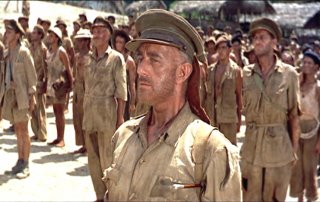
1957: From bad to worse; less films made in Hollywood, more being made abroad. Logic? It was cheaper. Only Paramount resisted the urge to sell off its entire catalogue of film output prior to 1948 to television – a move they too complied with the following year to boost capital for their dying empire. While quantity was down – quality was up. Racial scorchers, Sayonara and Island in the Sun were big hits. Jimmy Stewart had an unexpected flop with The Spirit of St. Louis – a compelling recanting of Charles Lindbergh that failed to find its audience. Fred Astaire proved he could still trip the light fantastic – this time with Audrey Hepburn in the sublime Parisian fantasy – Funny Face.
Grace Metalious’ sordid tale of small town bigotry and incest - Peyton Place reached the screen in a sanitized – though popular – form. Robert Mitchum played an ignoble bastard in Heaven Knows Mr. Allison. The court room drama Twelve Angry Men was impressive but only a critical success. The Bridge on the River Kwai swept the Oscars and made Alec Guinness a household word. His popularity had at long last crossed over to the U.S. Two talents discovered by film great Norma Shearer: Joanne Woodward and Robert Evans came into their own, as well as James MacArthur (son of Helen Hayes), Jean Seberg and Diane Varsi. Hollywood said goodbye to legends, Humphrey Bogart, Oliver Hardy (of Laurel and Hardy fame), tyrannical director Eric Von Stroheim and mogul par excellence, Louis B. Mayer. Director James Whale drowned in his swimming pool.
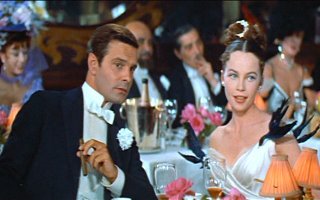
1958: Hollywood braced itself for another year of stiff competition from television. Their response this time was unique – more serious, better crafted movies: Edward Small’s Witness for the Prosecution (based on the Agatha Christie play), Cat on a Hot Tin Roof, Separate Tables, Indiscreet and Paths of Glory. Big was still in, with phenomenal returns on Auntie Mame, South Pacific, The Vikings and The Brothers Karamazov. Orson Welles’ Touch of Evil was truncated by Universal and unceremoniously ‘let loose’ on the American public without fanfare. It failed to find an audience. Hitchcock’s Vertigo received similar dismal reviews and revenues.
The Inn of the Sixth Happiness proved to be veteran actor, Robert Donat’s final performance. He died of cancer. Death also claimed elegant leading man, Ronald Colman, silent great H.B. Warner, film pioneer Jesse L. Lasky (of Famous Players fame). The year was capped off by two tragic deaths, producer Mike Todd, who was killed in a plane crash, and matinee idol Tyrone Power, who died in Madrid at the age of 44 while shooting Solomon and Sheba.
The biggest critical success of the year went to MGM’s Gigi – a rousing final nod to the great MGM musicals of old – this one too produced by veteran Arthur Freed and directed by Vincente Minnelli. It was the last major critical and financial success either of these two men would have.
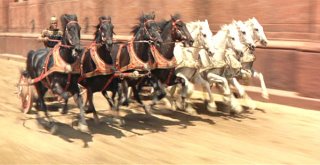
1959: Skin was in. Muscleman eye-candy Steve Reeves made Hercules in Italy wearing the skimpiest of costumes and came away with a colossal hit. Marilyn Monroe appeared in a tight negligee and later, almost-nude gown in her biggest success to date – Billy Wilder’s Some Like It Hot. Bridgette Bardot exuded undulating sex appeal in Love Is My Profession.
On the whole optimism in the industry was up – way up. Hitchcock had one of his most celebrated successes with North By Northwest – his only film for MGM. Publicity for the project trumpeted costar Eva Marie Saint – ‘the new Grace Kelly.’ Rock Hudson and Doris Day began their on screen partnership with the coy fresh faced romance Pillow Talk. Audrey Hepburn had one of her most challenging roles in The Nun’s Story. Powerful performances abounded in Stanley Kramer’s apocalyptic message picture On The Beach.
European cinema seemed to be having a good year too. Jeanne Moreau shocked and titillated in a censored version of The Lovers, France’s new wave reached a critical zenith with The 400 Blows, England’s Haley Mills stole the show from her father John in Tiger Bay, and Simone Signoret was given the Best Actress Oscar for Room at the Top.
MGM was the real winner of the year with its remake of Ben-Hur. Shot at Cinecitta Studios in Italy, the film gave Charlton Heston the best role of his career, swept the Oscars with 11 wins including Best Picture and became one of the all time money makers in film history.
Hollywood mourned the passing of some truly great legends including director Cecil B. DeMille, costume designer Gilbert Adrian, actress Ethel Barrymore, comedian Lou Costello, Paul Douglas, Errol Flynn, Kay Kendall, Mario Lanza, Victor McLaglen and everybody’s favorite Santa Claus - Edmund Gwenn.
@ Nick Zegarac 2006 (all rights reserved).
Stanley Kramer produced two enduring classics; Cyrano de Bergerac and The Men – the latter transforming the career of relative newcomer Marlon Brando into box office gold. The foreign film market delivered Devil in the Flesh and, Kind Hearts and Coronets; the latter introduced North American audiences to Alec Guinness and Peter Sellers. Britain’s most popular star, Michael Wilding appeared to reasonably good effect in one of Alfred Hitchcock’s minor thrillers; Stage Fright. Elizabeth Taylor, who would eventually marry Wilding, took her first stab at marriage to hotel heir, Nicky Hilton on May 6, declaring “I just love everything about getting married.”
Two of Hollywood’s most gifted screenwriters – Dalton Trumbo and John Howard Lawson were imprisoned for their political beliefs following a lengthy trial by HUAC. The unofficial blacklist included such names as song and dance man Gene Kelly, comedian Danny Kaye, tough guy Humphrey Bogart and sultry Lauren Bacall. The artistic community was saddened by the deaths of Sid Grauman (of Grauman’s Chinese Theater fame), Rex Ingram, and character actors Emil Janning, Sara Allgood, Alan Hale and Walter Huston.

1951: The specter of television continued to cut deep into every studio’s bottom line. MGM was particularly hard hit perhaps because television’s almost daily diet of light comedy and musical variety shows attacked their two most lucrative genres (the romantic comedy and the musical). Dore Schary, who had been appointed as head of production by L.B. Mayer took over the studio after Mayer was fired by East Coast Metro boss, Nicholas Schenk.
Detective Story, The Great Caruso, Oliver Twist were critical and financial successes. Disney’s Alice in Wonderland was only modestly received – mostly by those who hadn’t read the Lewis Carroll novel. The Red Badge of Courage proved a controversial film that did little business at the box office. Two debuts: opera sensation Ezio Pinza (in a flop; Mr. Imperium) and Rock Hudson (drawing swoons from a growing number of female admirers who wanted to see more.) Oscars to An American in Paris (Best Picture), Vivien Leigh (Best Actress for A Streetcar Named Desire) and Humphrey Bogart (Best Actor; The African Queen). Death claimed Warner Baxter and Jack Holt. Robert Walker (the elegant psychopath in Hitchcock’s Strangers on a Train) died of an allergic reaction.

1952: Hollywood turned to epics and westerns (the only two genres guaranteed box office) for its bread and butter. High Noon, Ivanhoe, The Snows of Kilimanjaro, Viva Zapata! and The Quiet Man were all critical and financial successes. Remakes of The Prisoner of Zenda and The Merry Widow failed to eclipse the resilient charm of their originals. But Scaramouche (starring Stewart Granger) was a popular and lavish update. In an effort to cut costs, MGM began experimenting with a new single-negative film stock – Anscocolor. Soon Fox and DeLuxe, and, Eastman-Kodak began developing their own single strip film stocks. None of their early efforts, however, could rival the rich hues and saturation of the old Technicolor process.
One of the grandest disappointments of the year was RKO’s highly publicized Androcles and the Lion, based on George Bernard Shaw’s play. Limelight proved to be the last film Charlie Chaplin produced in America. Elizabeth Taylor racked up husband #2; Michael Wilding on Feb. 21. The entertainment industry said goodbye to legendary stage chanteuse, Gertrude Lawrence, director Jack Conway, and actresses Gladys George and Hattie McDaniel.
New stars on the horizon included bronzed Apollo of the surf board set - Tab Hunter and cool ice princess (soon to be genuine princess) Grace Kelly. Comedy teams were all the rage: Abbott & Costello, Bing Crosby and Bob Hope, and, Dean Martin and Jerry Lewis were untouchable. Mario Lanza drew in big crowds. Honors (and the Best Picture Oscar) went to Cecil B. DeMille’s The Greatest Show on Earth. But the biggest buzz in town was This Is Cinerama – the first widescreen movie photographed and exhibited employing a cumbersome three camera/projector set up. It opened on Sept. 30, 1952 and played for a record 122 weeks!

1953: Drive in theaters became all the rage. Cavernous movie palaces – those deified centers dedicated to the once promising arts - began to close. 3-D made a big – though short-lived splash – with Bwana Devil. Widescreen technologies became all the rage – except that no one could decide on a standardized format. Mike Todd introduced his answer to Cinerama; Todd A-O. Paramount created VistaVision high fidelity. 20th Century Fox inaugurated Cinemascope – by far the most enduring of the early ventures. Fox’s first two films in Cinemascope, The Robe (though turgid and dull in action) and How to Marry a Millionaire were nevertheless colossal hits.
Not everybody went widescreen and those that did not, compensated by producing some very intelligently crafted product: Shane, The Band Wagon, Julius Caesar, Moulin Rouge and From Here to Eternity which won the Best Picture Academy Award. Disney was zero for two with another adaptation of a beloved British novel – Peter Pan – technically stunning, yet somewhat failed in its ability to recapture the spark of Barrie’s original.
Marilyn Monroe – merely glimpsed in her previous efforts (The Asphalt Jungle, All About Eve and Clash By Night) scored big as the treacherous two-timer in Niagara. Stage diva, Ethel Merman made her splashy return to films in a faithful adaptation of Irving Berlin’s Call Me Madam. The world was introduced to Dutch born gamin, Audrey Hepburn in Roman Holiday. Doris Day sought to ditch her squeaky clean façade by playing the lead in Calamity Jane – though nothing could entirely erase the fact that Ms. Day was in fact a lady.
Two other debuts worth noting: demure Julie Harris in The Member of the Wedding, and, Anthony Perkins in The Actress. Death took veteran actors William Farnum, Nigel Bruce, Herman Mankiewicz, Lewis Stone, Roland Young and Herbert Ralinson.
1954: Judy Garland marked her comeback to films with A Star Is Born – an epically tragic and thrilling musical remake. The uniquely original Seven Brides for Seven Brothers rang cash registers across the country. Brigadoon – the film version of Lerner and Loewe’s Broadway smash that MGM had invested more money, time and effort in – was only a modest success. All three films were shot in Fox’s patented Cinemascope widescreen process. Paramount inaugurated VistaVision High Fidelity with their loose remake of Holiday Inn, re-titled White Christmas.
Hitchcock thrilled audiences with his voyeuristic suspense, Rear Window. Otto Preminger attempted an all black version of Bizet’s Carmen – starring Dorothy Dandridge. On a more serious note, MGM produced Bad Day At Black Rock – a story of bigotry and murder in an isolated town. The Caine Mutiny, Three Coins in the Fountain and The High and the Mighty were all box office powerhouses. When asked about his involvement in the latter, John Wayne replied, “I’m no actor. I just react to situations and what’s said to me.”
Athlete Bob Mathias starred in a highly successful film about his own life. It was a banner year for Marlon Brando who appeared in Desiree, The Wild One and On The Waterfront – winning Best Actor and the New York Film Critics Award for his performance in the latter. Grace Kelly won Best Actress for The Country Girl. Veteran talents, Lionel Barrymore, Eugene Palette and Sidney (the Fat Man) Greenstreet both died.

1955: The biggest story of the year did not happen on the screen but on a lonely road in Salinas where promising new talent James Dean met with an untimely death in an auto accident. Dean, appeared in only three films; East of Eden, Rebel Without A Cause and the as yet unfinished Giant (costarring Elizabeth Taylor and Rock Hudson). Twenty-five year old Robert Francis – another promising talent was killed in a plane crash. Hollywood’s list of dead celebrities also included Carmen Miranda, John Hodiak and Theda Bara.
There was good news too: John Wayne remained top man at the box office for the tenth consecutive year. Marilyn Monroe had her biggest hit to date with The Seven Year Itch – a feather weight comedy all about a married man’s infatuation with the girl living directly above him. Rock Hudson became every woman’s fantasy. Hitchcock delivered one of his most slick and stylish thrillers, To Catch a Thief.
Mike Todd christened Todd A-O with a roadshow engagement of Rodgers & Hammerstein’s Oklahoma! The film was also shot in Cinemascope to accommodate theaters not equipped for Todd’s widescreen process. Samuel Goldwyn produced a film version of the Broadway smash Guys and Dolls. His first choice for the lead, Sky Masterson was dancer, Gene Kelly. Instead he settled on Marlon Brando who gave the performance of his career. Burt Lancaster turned his attentions to producing along with partner Ben Hecht. Their film debut, the modestly budgeted B&W- Marty won Best Picture.
1956: “We’ve got to do something to get people away from TV.” – Karl Malden. Those sentiments were echoed in Hollywood’s mammoth output. Cecil B. DeMille suffered a heart attack while making his last film – The Ten Commandments – but proceeded onward till the end. Paramount made a valiant attempt at bringing Tolstoy’s War and Peace to the screen but it proved a disheartening and dull experience.
Hollywood continued to pillage Broadway for its own fodder: The King & I, Anastasia, Tea and Sympathy, Picnic, Bus Stop, The Rain Maker and Carousel were among the better offerings. Of the output specifically crafted for the movies; Vincente Minnelli’s Lust for Life was the most engrossing and a tour de force for Kirk Douglas. Paul Newman had his breakout performance as fisticuffs champion Rocky Graziano in Somebody Up There Likes Me. Twenty-six year old Robert Wagner became the latest heartthrob.
Remakes were all the rage – at least as far as studios were concerned – though only a handful were successful; High Society (nee, The Philadelphia Story, 1940), The Spoilers and Moby Dick. The Opposite Sex (nee, The Women 1939) was a terrible flop. Laurence Olivier proved there was life in both Shakespeare and British cinema with Richard III. Alec Guinness continued to win fans west of the coast with The Ladykillers. Elvis Presley made a stunning film debut in Love Me Tender. But the biggest film of the year was Mike Todd’s Oscar-winning Around the World in 80 Days – a rollicking intercontinental adventure featuring cameos from every popular face of the period.
The artistic community was saddened by the loss of Bela Lugosi, Anne Crawford, Francis L. Sullivan, Louis Calhern and Jean Hersholt.

1957: From bad to worse; less films made in Hollywood, more being made abroad. Logic? It was cheaper. Only Paramount resisted the urge to sell off its entire catalogue of film output prior to 1948 to television – a move they too complied with the following year to boost capital for their dying empire. While quantity was down – quality was up. Racial scorchers, Sayonara and Island in the Sun were big hits. Jimmy Stewart had an unexpected flop with The Spirit of St. Louis – a compelling recanting of Charles Lindbergh that failed to find its audience. Fred Astaire proved he could still trip the light fantastic – this time with Audrey Hepburn in the sublime Parisian fantasy – Funny Face.
Grace Metalious’ sordid tale of small town bigotry and incest - Peyton Place reached the screen in a sanitized – though popular – form. Robert Mitchum played an ignoble bastard in Heaven Knows Mr. Allison. The court room drama Twelve Angry Men was impressive but only a critical success. The Bridge on the River Kwai swept the Oscars and made Alec Guinness a household word. His popularity had at long last crossed over to the U.S. Two talents discovered by film great Norma Shearer: Joanne Woodward and Robert Evans came into their own, as well as James MacArthur (son of Helen Hayes), Jean Seberg and Diane Varsi. Hollywood said goodbye to legends, Humphrey Bogart, Oliver Hardy (of Laurel and Hardy fame), tyrannical director Eric Von Stroheim and mogul par excellence, Louis B. Mayer. Director James Whale drowned in his swimming pool.

1958: Hollywood braced itself for another year of stiff competition from television. Their response this time was unique – more serious, better crafted movies: Edward Small’s Witness for the Prosecution (based on the Agatha Christie play), Cat on a Hot Tin Roof, Separate Tables, Indiscreet and Paths of Glory. Big was still in, with phenomenal returns on Auntie Mame, South Pacific, The Vikings and The Brothers Karamazov. Orson Welles’ Touch of Evil was truncated by Universal and unceremoniously ‘let loose’ on the American public without fanfare. It failed to find an audience. Hitchcock’s Vertigo received similar dismal reviews and revenues.
The Inn of the Sixth Happiness proved to be veteran actor, Robert Donat’s final performance. He died of cancer. Death also claimed elegant leading man, Ronald Colman, silent great H.B. Warner, film pioneer Jesse L. Lasky (of Famous Players fame). The year was capped off by two tragic deaths, producer Mike Todd, who was killed in a plane crash, and matinee idol Tyrone Power, who died in Madrid at the age of 44 while shooting Solomon and Sheba.
The biggest critical success of the year went to MGM’s Gigi – a rousing final nod to the great MGM musicals of old – this one too produced by veteran Arthur Freed and directed by Vincente Minnelli. It was the last major critical and financial success either of these two men would have.

1959: Skin was in. Muscleman eye-candy Steve Reeves made Hercules in Italy wearing the skimpiest of costumes and came away with a colossal hit. Marilyn Monroe appeared in a tight negligee and later, almost-nude gown in her biggest success to date – Billy Wilder’s Some Like It Hot. Bridgette Bardot exuded undulating sex appeal in Love Is My Profession.
On the whole optimism in the industry was up – way up. Hitchcock had one of his most celebrated successes with North By Northwest – his only film for MGM. Publicity for the project trumpeted costar Eva Marie Saint – ‘the new Grace Kelly.’ Rock Hudson and Doris Day began their on screen partnership with the coy fresh faced romance Pillow Talk. Audrey Hepburn had one of her most challenging roles in The Nun’s Story. Powerful performances abounded in Stanley Kramer’s apocalyptic message picture On The Beach.
European cinema seemed to be having a good year too. Jeanne Moreau shocked and titillated in a censored version of The Lovers, France’s new wave reached a critical zenith with The 400 Blows, England’s Haley Mills stole the show from her father John in Tiger Bay, and Simone Signoret was given the Best Actress Oscar for Room at the Top.
MGM was the real winner of the year with its remake of Ben-Hur. Shot at Cinecitta Studios in Italy, the film gave Charlton Heston the best role of his career, swept the Oscars with 11 wins including Best Picture and became one of the all time money makers in film history.
Hollywood mourned the passing of some truly great legends including director Cecil B. DeMille, costume designer Gilbert Adrian, actress Ethel Barrymore, comedian Lou Costello, Paul Douglas, Errol Flynn, Kay Kendall, Mario Lanza, Victor McLaglen and everybody’s favorite Santa Claus - Edmund Gwenn.
@ Nick Zegarac 2006 (all rights reserved).
No comments:
Post a Comment